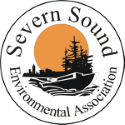The Natural Shorelines Project

When native plants are removed from shorelines, the natural beauty and character of the shoreline is lost, and wildlife habitat is altered. Without a natural shoreline, water quality can deteriorate and nuisance algae can grow, and there can be increased erosion of the shore by waves and ice.
The Natural Shorelines Project is an initiative to provide advice and assistance to landowners interested in protecting, enhancing or restoring a natural shoreline. Severn Sound Environmental Association provides tips on environmentally sound practices for shoreline properties, and can help landowners obtain appropriate native trees, shrubs, vines and wildflowers for shoreline restoration projects.
Natural Shorelines
- Shoreline vegetation improves water quality by trapping surface runoff, sediment, contaminants and excess nutrients before they enter the water.
- Native plants anchor the soil and protect the shoreline by reducing erosion from wind, waves and ice.
- A natural shoreline provides valuable habitat for plants and wildlife, and provides corridors for wildlife movement.
- A natural near-shore zone supports spawning and nursery areas for fish.
- Native plants are adapted to their environment and do not depend on chemical application or frequent watering to survive.
- Natural vegetation at the shoreline can deter nuisance geese, since they prefer to graze on mowed turf where they can see predators and they have easy access to water.
- Aquatic and semi-aquatic plants provide habitat for a variety of beneficial wildlife, including frogs, dragonflies and insect-eating birds.
Shoreline vegetation has a natural ability to adapt to changing water levels. Shoreline landowners can expect the extent of shoreline plants and coastal habitat to expand and contract over time, depending on lake levels and the slope and substrate of the near-shore.
On unaltered sites, preserving existing native vegetation is the best way of ensuring a healthy shoreline is maintained. On altered shorelines, replanting native vegetation and removing non-native species may be necessary to restore the shore to a natural condition.
The following are some general tips for creating and sustaining a healthy, natural shoreline.
- Establish and maintain a thickly vegetated, “no-mow, no-chemicals” buffer zone adjacent to the water’s edge to intercept runoff and provide habitat. Aim to maintain at least 75% of your shoreline frontage in a natural state.
- Preserve and encourage native natural shoreline vegetation in the near-shore zone.
- During low water levels, leave newly exposed areas undisturbed rather than infilling or modifying them, so that the habitat is available to plants, fish and wildlife when water levels rise again.
- Plan for a natural shoreline when building: maintain existing shoreline vegetation, and ensure buildings are appropriately set back from the shoreline.
- Minimize or eliminate impervious surfaces on your property: use woodchips, gravel or interlocking bricks that allow rainwater to infiltrate into the ground instead of running off over the ground.
- Design water access and docks to limit negative impacts on the shoreline. Floating, cantilever or post-supported docks are a good choice because they do not disturb the lake bottom or restrict the movement of water near the shore. Use environmentally-friendly building materials (e.g. untreated cedar or hemlock, plastic barrel floats free of chemicals) for any structures in the water.Natural vegetation at the shoreline can deter nuisance geese, since they prefer to graze on mowed turf where they can see predators and they have easy access to water.
- Keep your lot well treed: if a tree is interfering with your view, selectively prune branches rather than remove the whole tree.
- Maintain your septic system: pump out your septic tank regularly (every 2 to 3 years), and extend the life of your system by minimizing water consumption and avoiding septic tank additives.
- Use phosphorus-free, non-toxic soaps, detergents and cleaners in and around your home.
- Avoid using chemicals near the water. Not even ‘biodegradable’ soap should enter the water directly – it is only biodegradable on land, since it requires soil micro-organisms to break down.
- Refuel your boat carefully to avoid gas spills.
- Watch your boat’s wake – it can cause shoreline erosion and destroy fish and wildlife habitat.
- Learn to identify invasive plants and animals to prevent their spread.
- Do not blow or rake leaves or other yard waste into the water if you live on a lakefront or riverfront property. While natural in small, dispersed amounts, large concentrated amounts of yard waste can smother fish and invertebrate habitat, covering up eggs, nesting sites and nursery habitat. Bag your yard waste for collection, or better yet, use it as mulch or compost on your property.
For more information contact:
Michelle Hudolin, Wetlands & Habitat Biologist mhudolin@severnsound.ca
705-534-7283 ext. 202


